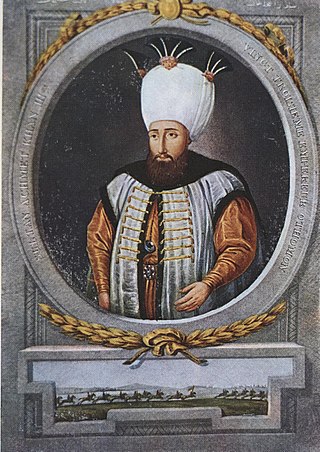
Ahmed III was sultan of the Ottoman Empire and a son of sultan Mehmed IV. His mother was Gülnuş Sultan, originally named Evmania Voria, who was an ethnic Greek. He was born at Hacıoğlu Pazarcık, in Dobruja. He succeeded to the throne in 1703 on the abdication of his brother Mustafa II (1695–1703). Nevşehirli Damat İbrahim Pasha and the Sultan's daughter, Fatma Sultan directed the government from 1718 to 1730, a period referred to as the Tulip Era.

Abdulhamid or Abdul Hamid I was the 27th sultan of the Ottoman Empire from 1774 to 1789.

Mahmud I, known as Mahmud the Hunchback, was the sultan of the Ottoman Empire from 1730 to 1754. He took over the throne after the quelling of the Patrona Halil rebellion. His reign was marked by wars in Persia and conflicts in Europe. He delegated government affairs to his viziers and devoted time to writing poetry. Nader Shah's devastating campaign weakened the Mughal Empire and created the opportunity for Mahmud I to initiate war with cooperation from Muhammad Shah. The alliance ended with the latter's death, leading to tensions between the Afsharids and the Ottomans.

Abdulmejid II was the last Ottoman caliph, the only caliph of the Republic of Turkey, and head of the Osmanoğlu family from 1926 to 1944. As opposed to previous caliphs, he used the title Halîfe-i Müslimîn, instead of Emîrü'l-Mü'minîn.

The Sultanate of Rûm was a culturally Turco-Persian Sunni Muslim state, established over conquered Byzantine territories and peoples (Rûm) of Anatolia by the Seljuk Turks following their entry into Anatolia after the Battle of Manzikert (1071). The name Rûm was a synonym for the medieval Eastern Roman Empire and its peoples, as it remains in modern Turkish. The name is derived from the Aramaic (rhπmÈ) and Parthian (frwm) names for ancient Rome, via the Greek Ῥωμαῖοι (Romaioi).
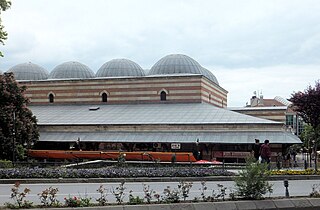
A bedesten is a type of covered market or market hall which was historically found in the cities of the Ottoman Empire. It was typically the central building of the commercial district of an Ottoman town or city, where the most important and precious goods were kept and sold. Its function was comparable or equivalent to that of a qaysariyya in other regions, though the architecture of the latter could be different and be similar to that of a bazaar with its own streets.

Sünbül Sinan Efendi was the founder of the Sunbuliyye Sufi order. The Sunbuliyye were a derivative of the Khalwati order. Sünbül Efendi's successors, the next generations were settled in Nurullah town by Konur, Icel Province around 1550.
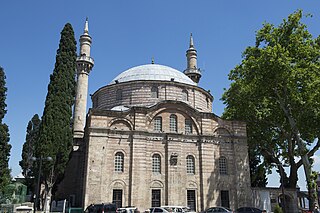
The Emir Sultan Mosque is in Bursa, Turkey. First built in the 15th century, it was rebuilt in 1804 for the Ottoman sultan Selim III, and rebuilt again in 1868, the plan of the mosque changing slightly with each rebuild.

The Old Mosque, also known as Grand Mosque, is an early 15th-century Ottoman mosque in Edirne, Turkey.

Aziz Mahmud Hudayi (1541–1628),, is amongst the most famous Sufi Muslim saints of the Ottoman Empire. A mystic, poet, composer, author, statesman and Hanafi Maturidi Islamic scholar, he was the third and last husband of Ayşe Hümaşah Sultan, granddaughter of Sultan Suleiman the Magnificent.
The İslâm Ansiklopedisi (İA) is a Turkish academic encyclopedia for Islamic studies published by Türkiye Diyanet Foundation.

The following outline is provided as an overview of and topical guide to the Ottoman Empire:

Yakutiye Madrasa is a historical 14th-century Madrasa in Erzurum, Turkey. The madrasa was built in 1310 by order of a local governor of the Ilkhanids, Hoca Yakut, and it is named after him.
Hatice Sultan was an Ottoman princess, the daughter of Mehmed IV, and his Haseki Emetullah Rabia Gülnuş Sultan. She was the sister of Sultans Mustafa II and Ahmed III.
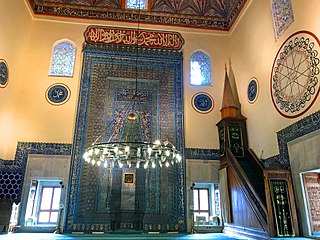
Early Ottoman architecture corresponds to the period of Ottoman architecture roughly up to the 15th century. This article covers the history of Ottoman architecture up to the end of Bayezid II's reign, prior to the advent of what is generally considered "classical" Ottoman architecture in the 16th century. Early Ottoman architecture was a continuation of earlier Seljuk and Beylik architecture while also incorporating local Byzantine influences. The new styles took shape in the capital cities of Bursa and Edirne as well as in other important early Ottoman cities such as Iznik. Three main types of structures predominated in this early period: single-domed mosques, "T-plan" buildings, and multi-domed buildings. Religious buildings were often part of larger charitable complexes (külliyes) that included other structures such as madrasas, hammams, tombs, and commercial establishments.
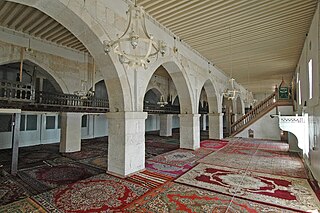
Ermenek Grand Mosque is located on the outskirts of Ermenek Castle on an outcrop that overlooks the city of Ermenek. The mosque was built by Mahmud Bey of the Karamanids in 1302AD (702AH), as inscribed in Sülüs-style calligraphy on the original door wings between the antechamber and the prayer hall.
Sayyid Medeni Mehmed Nuri Efendi was an Islamic scholar, qadi (judge), and the last Sheikh-ul-Islam of the Ottoman Empire.

The Great Mosque of Malatya was a Seljuk mosque in Battalgazi, Malatya Province, Turkey. The mosque was originally built in the 13th century, and was destroyed in the 2023 Turkey–Syria earthquake.














